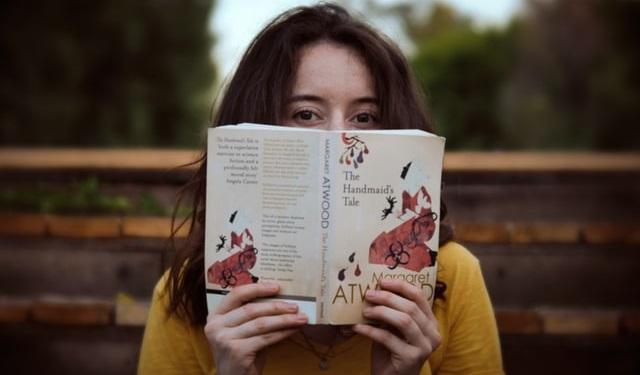
Many works of dystopian fiction deal with oppressed populations based on ethnicity, religion, gender, nationality and more; one such text is The Handmaid’s Tale by Margaret Atwood (1986). The novel presents the difficult story of a tormented woman within an utterly patriarchal dystopian society and thus can clearly be read through the lens of the feminist reader. The novel, however, offers another theoretical possibility of interpretation, which might not be as initially noticeable, yet it is incorporated in the text all the same: postcolonialism.
This paper will demonstrate and compare how the two different literary theories – feminism and postcolonialism – are embodied in The Handmaid’s Tale; and how the text actually highlights the almost identical similarities between the theories.
It is first important to explain why The Handmaid’s Tale can be read not just from a feminist perspective but from a postcolonial one as well. The Republic of Gilead is the name of the fictional new totalitarian patriarchal regime that takes over the United States and administers horrible treatment and regard of women. This regime does not derive its power and authority merely from chauvinistic or misogynistic ideals but from a real problem that plagued the fictional former United States and the rest of the world: a sharp drop in birthrate, “down past the zero line of replacement, and down and down” (chapter 19). Gilead is thus a dictatorial ruling system that seeks to colonize and exploit to the full the most imperative resource in the fictional world: fertile women.
There are more indications in the text for the treatment of women as a precious colonized resource that needs to be preserved, at least to a certain degree: Offred, the oppressed narrator herself, admits, “Women were not protected” before Gilead whilst now “no man shouts obscenities at us, speaks to us, touches us” (5); additionally, sexual assaults of women in Gilead are being regarded as an extremely severe crime, for instance “[t]he penalty for rape … is death” (43).
If so, while Gilead might initially appear merely as an utterly misogynistic regime, it is actually more of a patriarchal colonizing power that strives to utilize women as a resource for procreation purposes. This doubly oppressive hybrid is not atypical for Margaret Atwood; as other scholars have already noted about her writing in general, Atwood’s “characters are colonized by patriarchy, cultural imperialism, and geographical colonization” (Zidan, 2013).
The initial literary device that aligns with the endeavors of feminist and postcolonial theories is evident right from the very beginning: the voice and point of view of the narrator herself, from which almost the entire story is retold. The Handmaid’s Tale is a first-person narrative in the present tense in which the narrator, Offred, is also a character who is part of the oppressed group in the fictional world. While Offred is a powerless and silenced woman in the story world, her voice as the narrator gives her all the power outside of it; the readers can only understand the story through her own perspective, her own voice, her own words, and her own feelings.
Ascribing all the narrated control to the oppressed is not a common literary convention: for instance, the feminist critics Sandra Gilbert and Susan Gubar discuss the general exclusion and lack of female voices in literature as “Western literary history is overwhelmingly male” (1979); and similarly, the postcolonial theorist Gayatri Spivak concludes her discussion about colonial discourse by stating that “[t]he subaltern cannot speak” (1994: 104), as the subaltern represents the oppressed colonized cultures. Immediately from the readers’ first encounter with the text, therefore, The Handmaid’s Tale defies the very same prevalent practices that feminist and postcolonial theories decidedly seek to alter as well.
A significant part of the struggle of feminism and postcolonialism is inequitable property and ownership rights of the oppressed. In The Handmaid’s Tale, one of the first strategical moves of the new oppressive patriarchal regime of Gilead right after it takes control is to strip away such rights from the female population. Offred recalls how her friend Moira told her that the government had frozen “[a]ny account with an F [female] on it instead of an M [male]” and that “[w]omen can’t hold property any more … It’s a new law” (28); from that point onwards, women in Gilead had to rely entirely on their husbands or on male next of kin financially.
Similar hardships concerning property rights are a cardinal topic in postcolonial studies. In practically all colonized countries, the colonizers instituted new systems of private property laws, first initiated in British colonies, which chiefly benefited, of course, the colonial powers themselves (Fails and Krieckhaus, 2010: 492-3). One example of such colonial property law comparable to the aforementioned events of The Handmaid’s Tale is the Indian Removal Act of 1830 in the U.S. that was signed by President Andrew Jackson, which essentially gave the government the full authority to seize lands of Native Americans forcefully. Equivalently, property and ownership rights have been a cardinal issue against whom women were discriminated against historically, and it is thus no surprise that it was at the forefront of first-wave feminism since its very early stages in the nineteenth century.
One of the earliest leaders of the women’s rights movement, Elizabeth Cady Stanton, expressed her great indignation concerning women’s property rights in the famous 1848 Declaration of Sentiments and Resolutions (from the first women’s rights convention in Seneca Falls, New York): “He has taken from her all right in property, even to the wages she earns.” Indeed, only since feminist political activists first began operating in the nineteenth century in North America and Europe, women’s property rights have gradually been equated with men’s rights (examples: Married Women’s Property Act 1870, 1882, 1883, 1884 in the United Kingdom; The Married Women’s Property Acts by states of the United States since 1839; Women can open a bank account under their name in France, 1881).

Whilst both postcolonial and feminist theories stress the struggle for equal property rights, the revocation of women’s property rights in The Handmaid’s Tale bears more resemblance to postcolonial theories than to feminist theories in the sense that the rights of the colonized were taken away from them, whereas women had essentially begun with almost no such rights at all and have progressively won them.
A horrible aspect that appears in postcolonial and feminist theories – and which is conspicuously featured in The Handmaid’s Tale as well – is the utilization of violence as a means to punish and “teach” the oppressed group. In The Handmaid’s Tale, Offred recounts how her friend Moira is punished by the Angels (Gilead’s soldiers) for trying to “fake sick”: she explains that it is Moira’s “first offence” so she is beaten with “steel cables, frayed at the ends” on her feet, and “[a]fter that the hands,” because the Handmaids’ feet and hands “are not essential”; Offred adds that thereafter the injured “Moira lay on her bed, an example” for the other Handmaids (15).
Additional prevalent kind of violent punishment in Gilead is the practice of publicly hanging violators “by the necks, their hands tied in front of them, their heads in white bags tipped sideways onto their shoulders” and a placard around their neck indicating the nature of their crime (6) – which is, of course, another form of intimidation by violence as well. These sorts of violent punishments in the fictional world were quite common in colonized countries in the real world, especially in British colonies where whipping, caning and beating had been enforced as actual legal punishments (Bernault, 2007).
Emphasizing this issue, Edward Said – who is commonly considered the harbinger of postcolonial studies by many postcolonial scholars – sarcastically describes that in colonized territories, “flogging or death or extended punishment being required when ‘they’ misbehaved or became rebellious, because ‘they’ mainly understood force or violence best” (Said, 1993). Even more than in postcolonial theories, violence is a salient topic in feminist theories too, and for understandable reasons. Until the second half of the nineteenth century, the common law in leading Western countries such as the U.S. and the U.K. allowed husbands to subject their wives to corporal punishment that did not inflict permanent injury as part of a patriarchal notion that the man was the “master of his household”; but even after marital chastisement was abolished, feminist movements have been battling ever since with the authorities that have often granted immunities for beating husbands to protect concepts such as “family privacy” (Siegel, 1995).
In most Western countries, feminist movements did manage to effect legislative change over the past few decades; for instance, the Violence Against Women Act of 1994 in the U.S., the Domestic Violence, Crime and Victims Act 2004 in the U.K., and the Family Law Act 1975 in Australia (amended in 2006). However, there has also been a regression in some countries, such as Russia; for instance, a law that decriminalizes the first offense of domestic violence was signed by President Putin in February 2017. The violence against women in The Handmaid’s Tale is systematic and chiefly carried out by the authorities themselves. Therefore it is, again, more similar to the violence portrayed in postcolonial studies rather than in feminist studies, which decry the legal position that allows violence against women, yet it is not executed by the authorities as in colonized countries.
Both postcolonial and feminist theories fiercely reject the faulty prejudiced premise that the dominating culture is intellectually, mentally and sometimes physically superior to the oppressed group; such bigoted preconceptions are poignantly manifested in The Handmaid’s Tale too. The Commander, who is one of Gilead’s head leaders, explains to Offred that the subjection of women to the reproductive needs of Gilead actually allows women to “fulfil their biological destinies in peace,” as if the only functionality of women is to give birth; later on, the Commander adds that all they do in Gilead is to “return things to Nature’s norm,” indicating that the current state of women’s oppression is natural (34).
Due to their alleged inferior state, women in Gilead are not being represented politically anymore, not even Serena Joy, who was one of the leading female figures of the coup; before Gilead, Joy had preached “about how women should stay home,” but Offred currently thinks of “[h]ow furious she must be, now that she’s been taken at her word” (8). The blame for the drop in birthrate also falls on women’s purported deficiency: in Gilead, one cannot say “sterile man any more, not officially. There are only women who are fruitful and women who are barren, that’s the law” (11), signifying that only women can be physically inferior.
This horrid discriminatory ideology in Gilead has many parallels to the colonial stance in colonized countries. In his constitutive work in the field of postcolonial studies, Orientalism, Edward Said outlines the prejudicial approach of the Occident (the colonizing West) to the Orient (the colonized East) by quoting notable colonial British figures such as Arthur Balfour and Lord Cromer, who characterize the Orient by a set of poorer, lesser qualities compared to the better, higher ones of the Occident (Said, 1978: 38-9). Said goes on to elaborate on the general perception of the colonizer: “The Oriental is irrational, depraved (fallen), childlike, ‘different’; thus the European is rational, virtuous, mature, ‘normal’” (Said, 1978: 40) – an attitude that reflects quite accurately the mindset of Gilead’s ruling class.
Of course, perceiving women as inferior and consequently excluding them from positions of influence is probably the main issue of virtually all feminist theories. One famous comprehensive feminist work that reviews the perception of male supremacy in various areas of life is The Man-Made World (1911) by one of the most renowned feminist writers in history, Charlotte Perkins Gilman. According to Gilman, by regarding women as inferior, the male gender has “monopolized all human activities” such as science, art, government, education, religion, etc., and created an exclusively masculine sphere which Gilman has coined as “Androcentric Culture” (Gilman, 2011: 13-4) – a definition that in its purest form loudly echoes society in Gilead. Gilman’s description of the opposers to the suffrage of women mirrors almost precisely the viewpoint of The Handmaid’s Tale’s Commander: “They see the woman only as a female, utterly absorbed in feminine functions, belittled and ignored,” while they see the man as “the sole master of human affairs for as long as we have historic record” (Gilman, 2011: 110).
If so, both postcolonial and feminist theories can be fittingly applied in this regard to The Handmaid’s Tale – the authoritarian regime in Gilead views women as inferior in a similar manner to how either colonizing powers view colonized populations and how patriarchal societies view women.
There is no doubt that Offred endures in The Handmaid’s Tale cruel and vicious subjugation; yet, this is not solely because of the anti-feminine agenda of Gilead’s regime but also because it regards fertile women as a vital resource for the survival of the species due to rapidly declining birthrates, and hence women are needed to be controlled and exploited.
This fictional scenario creates an interesting intersection where two different literary theories, feminism and postcolonialism, meet. This collision illustrates the strong correlation between the two theories and demonstrates how the two different oppressed groups withstand similar hardships and injustices in areas such as suppression of voice, ownership rights, use of violence, and superior/inferior prejudices; additionally, it exhibits that human beings who possess atrocious ideologies employ similar means and justifications to actualize their abhorrent ideas into abhorrent reality.
The Handmaid’s Tale is obviously a fictional story, but unfortunately, it dramatizes literary theories – feminism and postcolonialism – that are based on real life. Hopefully, the novel can exemplify why discriminatory ideologies should be repelled unequivocally.
Works Cited
Atwood, Margaret. The Handmaid’s Tale (Kindle Edition). Amazon Digital Services LLC (originally by Houghton Mifflin Harcourt). 1986.
Bernault, Florence. “The Shadow of Rule: Colonial Power and Modern Punishment in Africa.” Cultures of Confinement: A History of the Prison in Africa, Asia and Latin America. 2007. pp. 77-79.
Fails, Matthew D., and Jonathan Krieckhaus. “Colonialism, Property Rights and the Modern World Income Distribution.” British Journal of Political Science 40.3. 2010. pp. 487-508.
Gilbert, Sandra, and Susan Gubar. “Infection in the Sentence: The Woman Writer and the Anxiety of Authorship.” The Madwoman in the Attic: The Woman Writer and the Nineteenth-Century Literary Imagination, second edition. 1979.
Gilman, Charlotte Perkins. The Man-Made World: Our Androcentric Culture. The Floating Press. 2011 (first published in 1911).
Said, Edward. “Introduction” (xi) to Culture and Imperialism. New York: Vintage. 1993.
—. Orientalism. New York: Pantheon. 1978. pp. 38-40.
Siegel, Reva B. “The Rule of Love: Wife Beating as Prerogative and Privacy.” Yale LJ 105. 1995. pp. 2118-2122.
Spivak, Gayatri Chakravorty. “Can the Subaltern Speak?” in Colonial Discourse and Post-Colonial Theory: A Reader. Williams, Patrick and Laura Chrisman (Eds.). New York: Columbia University Press. 1994. p. 66-111.
Zidan, Ashraf Ibrahım. “Postcolonial Feminism in Margaret Atwood’s Fiction.” International Journal of Linguistics and Literature 2.3. 2013. p. 17.



